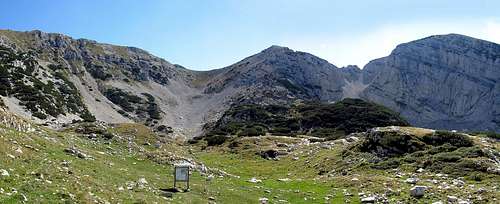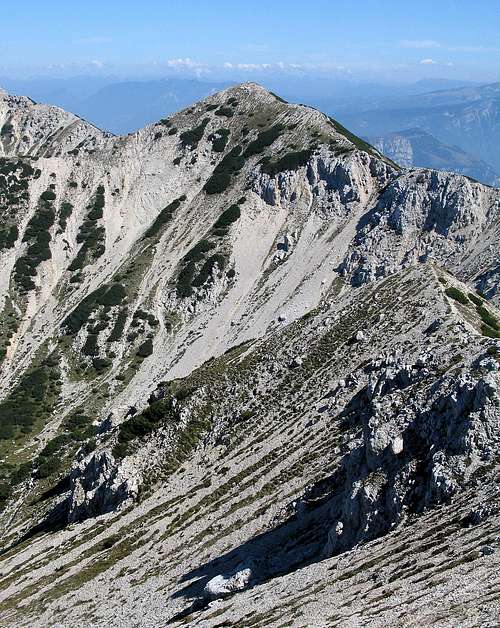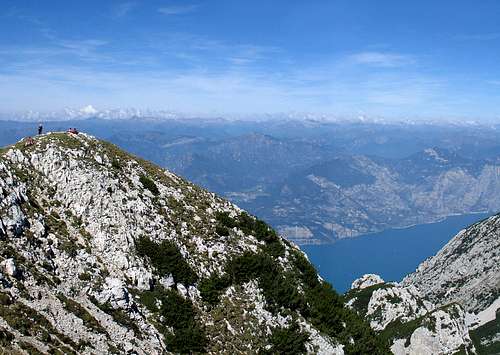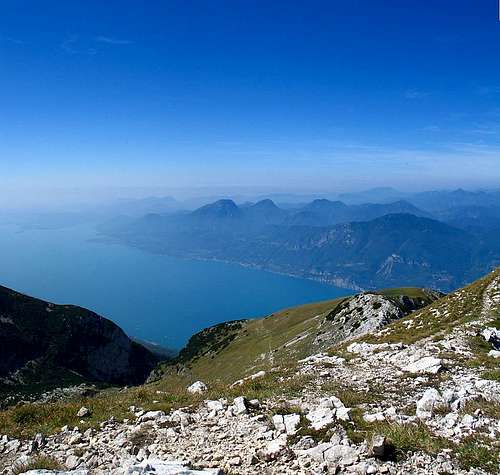|
|
Mountain/Rock |
|---|---|
|
|
45.74400°N / 10.85780°E |
|
|
7218 ft / 2200 m |
|
|
overview
The long ridge of Monte Baldo has its summit in the Punta Telegrafo (2206m) dominating, on the west side the Garda lake and on the other side the Adige valley.The two main slopes of the mountain have very different features: to the west a compact, very steep and wild structure, thickly covered by woods and brushes; to the east sweet slopes hosting wide pasture plains before the big crack of the Adige valley where the side ends with rocky walls.
We can remember that Monte Baldo, once "sheperds mountain" due to the wide pastures tapped from long time, is also known as the "garden of Italy" for the great quantity and rarity of plant species and for its spectacular blooms. Many species come from glacial residues still living on the mountain that was like an island into the big glaciers.
la lunga dorsale del monte Baldo culmina con la Punta Telegrafo 2206mt.che domina dal lato occidentale il lago di Garda e dall'altro lato la Valle dell'Adige.
I due versanti principali del rilievo montuoso del Baldo presentano caratteristiche nettamente diverse: Verso il lago di Garda è una compatta struttura, molto ripida e selvaggia fittamente coperta a boschi e boscaglia. Verso est, invece, presenta declivi che a tratti formano ampie piattaforme pascolive prima della grande spaccatura della Val d'Adige sulla quale si affacciano muraglie rocciose.
Ricordiamo che Il Baldo, un tempo la montagna dei pastori per via delle grandi zone di pascolo sfruttate da tempi immemorabili, è anche definito il giardino d'Italia per la straordinaria quantità e rarità di specie vegetali ed in particolare per le spettacolari fioriture. Molte di esse sono residui glaciali sopravvisuti sul monte che emergeva come un'isola tra le enormi colate di ghiaccio.
Glacial circle
Monte Baldo has 7 glacial circles, among them the Telegrafo's one.
It includes the circle of Telegrafo and, lower, the one of the Nogare valley.
Between the Cima Scascaga (2136m) and the Cima Telegrafo (2200m) there are some evident ice-splits with big dolomitic boulders and many straight drills.
The circles, easy to reach from Rifugio Mondini (1500m - cableway), are really interresting for their flora and fauna; they are wide circular holes digged by the branches of the big glacier that, in Quaternary era, was in the Garda lake basin.
circolo glaciale
Il Baldo presenta 7 circhi glaciali, tra cui quello del Telegrafo.Esso comprende i circhi del Telegrafo e, più in basso, quello della Valle delle Nogare. Compreso tra Cima Scascaga (m 2.136) e Cima Telegrafo (m 2.200), presenta fenomeni di gelifrazione molto più accentuati, con imponenti massi dolomitici erosi e numerosi solchi rettilinei. I circhi, raggiungibili più facilmente dal rifugio Mondini (m 1.500), cui si può salire anche in cabinovia da Prada, sono particolarmente interessanti per la fauna e la flora.I circhi glaciali sono una caratteristica del versante occidentale del monte baldo.Essi sono vaste cavità circolari scavate e lavorate dai rami del grande ghiacciaio che nell'era quaternaria occupava il bacino del grande lago di garda
Getting There
Garda LakeArrival and getting around
Following you can find some useful information about arriving and getting around lake Garda:
By car
Lake Garda is reached by the motorways A4 Milan/Venice (exits Peschiera del Garda, Sirmione or Desenzano del Garda) or by the A22 Brennero/Modena (exits Rovereto sud/lago di Garda nord or Affi/lago di Garda sud).
By train
The main railway station is "Porta Nuova” in Verona. Another station, directly on the lake, is Peschiera del Garda on the Milan/Venice line. For information about time tables and prices: www.trenitalia.com.
From the railway station in Verona you can reach lake Garda by using the regional, blue colored buslines. Information: +39-045-8057911 or www.apt.vr.it .
By plane
Airport Valerio Catullo in Verona-Villafranca
The international airport Valerio Catullo in Verona-Villafranca is situated approx. 15 km from lake Garda. For information: +39-045-8095666 or www.aeroportoverona.it. There is a shuttle-bus service to and from the airport from the railway station Verona Porta Nuova every 20 minutes. Information: +39-045-8057911 or www.apt.vr.it.
Airport Gabriele d'Annunzio in Brescia-Montichiari
The small airport Gabriele d'Annunzio in Brescia-Montichiari is situated just some kilometers away from Desenzano del Garda and offers low cost flights especially to England. Information: +39-030-9656599-511 or www.aeroportobrescia.it . There is also a daily shuttle bus service to and from Brescia Montichiari airport. Information: +39-030-9656511 or www.aeroportobrescia.it .
Airport Orio al Serio in Bergamo
The airport Orio al Serio in Bergamo is about 80 kilometers away from lake Garda and offers a vast selection of low cost flights to lots of europeen cities. Information: +39-035-326323 or www.orioaeroporto.it
From all airports we reccomend the transferservice wich offers a comfortable shuttle from and to all towns on lake Garda: http://transfer.limtours.it/index.
Taxi
Taxi are present 24 hours in front of the railway stations and the arrival terminals of all airports.
Routes
to Rifugio Telegrafo e Cima TelegrafoAvio (147 M.) -Path 652 - Rif. Telegrafo (2147 M.)
Assenza (66 M.) - Path 654 - Rif. Telegrafo (2147 M.)
Novezzina (1255 M.) - Path 657 - Rif. Telegrafo (2147 M.)
Caprino Veronese(253 M.) - Path 662 - Bocchette di Naole (1648 M.) - 658 - Rif. Telegrafo (2147 M.)
Prada - (Seggiovia) - Rif. Chierego (1911 M.) - Path 658 - Rif. Telegrafo (2147 M.)
Malcesine (66 M.) - (funivia) - Bocca Tratto Spino (1752 M.) - Path 651 - Rif. Telegrafo (2147 M.)
ski-mountaneering - sci alpinismo
The eastern side of Monte Baldo is ploughed by snow channels that go down steep from the ridge and that, once full of debris, give origin to those white regular stripes that can be easily seen from Verona.Very tiring and rarely climbed in summer, they are, on the contrary, when snow covers the gravels ans stones, very fine for ski mountaneering.
The most known and climbed is the Osanna valley, coming down from Cima Telegrafo: must be done only with safe conditions of the snow (normal here due to the orientation that allows to receive sunrays from the first lights of the day)
Il versante orientale del Monte Baldo è solcato da canali nivali che scendono ripidi direttamente dal crinale e, colmandosi di detriti, danno origine a quelle regolari venature bianche, inconfondibile caratteristica della faccia "veronese", ben visibile dalla città.
Faticosi e molto raramente percorsi in estate, offrono invece notevoli itinerari di alpinismo e scialpinismo, anche impegnativo, quando la neve ne copre le ghiaie e i massi del fondo.
Di tutti il Vallone Osanna, che scende direttamente da Cima Telegrafo, caratterizzato dall'ingombrante presenza dei nuovi piloni della teleferica del rifugio, è quello più conosciuto e percorso solo con neve assolutamente sicura, cosa per altro non infrequente data l'esposizione al sole fin dal primo mattino.








